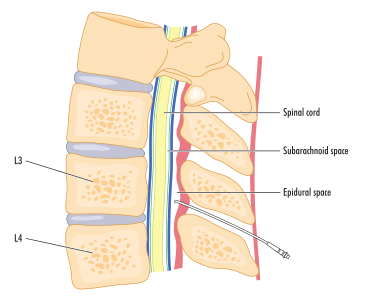What is a spinal injection?
A spinal injection refers to the administration of medication into the spinal column. This procedure is often used to diagnose and treat various conditions affecting the spine, spinal cord, and surrounding structures.
It's important to note that while spinal injections can be effective in managing certain conditions, they are not always a standalone solution. They are often used as part of a comprehensive treatment plan that may include physical therapy, medication, and other interventions.

Types of spinal injection
There are different types of spinal injections, and they can be used for various purposes. Some common types include:
Epidural Steroid Injection (ESI): This involves injecting a corticosteroid medication into the epidural space, which is the area around the spinal cord and nerves. ESIs are often used to reduce inflammation and alleviate pain caused by conditions such as herniated discs, spinal stenosis, or sciatica.
Facet Joint Injection: This injection targets the small joints located between each vertebra in the spine (facet joints). It typically involves injecting a combination of a local anaesthetic and a corticosteroid into these joints to reduce pain and inflammation associated with facet joint arthritis or other conditions.
Spinal Nerve Block: This injection is aimed at blocking the pain signals transmitted by specific nerves in the spine. It may involve injecting a local anaesthetic, a steroid, or both near the affected nerve to provide pain relief.
Discography: This is a diagnostic procedure in which contrast dye is injected into one or more spinal discs to identify the source of back pain. It helps to assess the condition of the intervertebral discs and can guide treatment decisions.
Sacroiliac Joint Injection: The injection is administered into the sacroiliac joint, which connects the spine to the pelvis. It may contain a local anaesthetic and a corticosteroid to reduce pain and inflammation associated with sacroiliac joint dysfunction.
What is a spinal injection for?
Spinal injections serve various diagnostic and therapeutic purposes for conditions affecting the spine, spinal cord, and surrounding structures. This includes:
Pain Management: Spinal injections are frequently used to manage pain associated with various spinal conditions. Conditions such as herniated discs, spinal stenosis, facet joint arthritis, and sciatica can cause significant pain. Injections may include local anaesthetics and anti-inflammatory medications to reduce pain and inflammation.
Inflammation Reduction: Conditions like herniated discs or spinal stenosis can lead to inflammation around the spinal nerves. Corticosteroids, which have potent anti-inflammatory effects, are often used in epidural steroid injections to reduce inflammation and alleviate associated pain.
Diagnostic Purposes: Some spinal injections, like discography, are primarily diagnostic. They help identify the source of back pain by introducing contrast dye into specific spinal discs and observing how the dye spreads or leaks, providing valuable information about the condition of the intervertebral discs.
Nerve Blocks: Spinal nerve blocks can be used to interrupt pain signals transmitted by specific nerves. This can be especially useful in diagnosing the source of pain and providing temporary relief for conditions like radiculopathy or neuropathy.
Facet Joint Issues: Injections into the facet joints can be both diagnostic and therapeutic for conditions such as facet joint arthritis. The injection may include a local anaesthetic to provide immediate pain relief and a corticosteroid for longer-term inflammation reduction.
Post-Surgical Pain: Spinal injections can be used to manage pain following certain spinal surgeries. They may be administered directly into the surgical site or adjacent areas to alleviate postoperative pain and inflammation.
Sacroiliac Joint Dysfunction: Injections into the sacroiliac joint can be used to manage pain and inflammation associated with dysfunction in this joint, which connects the spine to the pelvis.
What happens during a spinal injection?
The area of the back where the injection will be administered is cleaned and sterilised. A local aneasthetic may be applied to numb the skin and tissues at the injection site. This helps minimise discomfort during the procedure.
In many cases, imaging guidance such as fluoroscopy (a type of X-ray) or ultrasound is used to ensure precise placement of the needle. This is important for the safety and accuracy of the injection.
Once the area is numb, a thin needle is inserted through the skin and deeper tissues. The medication is then injected through the needle into the targeted area.
Recovery from a spinal injection
After the injection, you will be observed for a short period to monitor for any immediate adverse reactions.
Most patients can resume normal activities shortly after the procedure, but some may be advised to take it easy for a certain period.
It's common for patients to experience some tenderness at the injection site, which usually resolves within a day or two.
Guide price for self-pay patients
Facet joint injection (under x-ray control) up to 2 joints
| Consultation | Diagnostics | Treatment | Care after discharge | |
|---|---|---|---|---|
| Hospital costs | Included | From £350 | £1630 | Included |
| Consultant costs | From £220 | Included | Included | Included |
| Estimated total cost | £2200 | |||
| Estimated length of stay | Day case | |||
Facet joint injection (under x-ray control) up to 3-4 joints
| Consultation | Diagnostics | Treatment | Care after discharge | |
|---|---|---|---|---|
| Hospital costs | Included | From £350 | £1800 | Included |
| Consultant costs | From £220 | Included | Included | Included |
| Estimated total cost | £2370 | |||
| Estimated length of stay | Day case | |||
Facet joint injection (under x-ray control) up to 5-6 joints
| Consultation | Diagnostics | Treatment | Care after discharge | |
|---|---|---|---|---|
| Hospital costs | Included | From £350 | £1930 | Included |
| Consultant costs | From £220 | Included | Included | Included |
| Estimated total cost | £2500 | |||
| Estimated length of stay | Day case | |||
The prices in the table above (the “Guide Prices”) show what most patients should expect to pay at each appointment and on admission to hospital.
The Guide Prices you pay might be different depending on your medical history.
Your price quotation will be made clear to you before you proceed with any tests, consultations or treatment.
Consultants that perform this procedure
Self-pay

As a private patient, you don't have to wait for our outstanding care.
Health insurance

Our services are recognised by most of medical insurance companies.
Payment plans

Spread the cost of your treatment with Horder Healthcare 0% payment plans
Get referred to The Horder Centre today
The Horder Centre provides the highest quality services to NHS, privately insured and self-pay patients, from initial consultation and diagnostic tests right through to surgical treatment and rehabilitation.
We are rated as a 5* healthcare provider
Read our latest patient reviews on the NHS Choices website.








